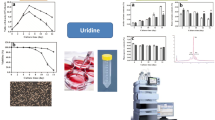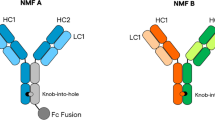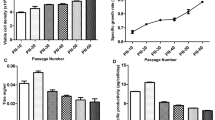Abstract
Over the past decade, global interest in the development of therapeutic monoclonal antibodies (mAbs) has risen rapidly. As therapeutic agents, antibodies have shown marked efficacy in combatting a range of cancers and immune diseases with high target specificity and low toxicity (Carla Lucia et al. in PLoS ONE 6:e24071, 2011; Donaghy in MAbs 8:659–671, 2016; Nasiri et al. in J Cell Physiol 9:6441–6457, 2018; Teo et al. in Cancer Immunol Immunother 61:2295–2309, 2012). Recent advances in cell culture technology, such as high-throughput clone screening, have facilitated antibody production at concentrations exceeding 10 g/L (Chen et al. in BMC Immunol 19:35, 2018; Huang et al. in Biotechnol Prog 26:1400–1410, 2010; Lu et al. in Biotechnol Bioeng 110:191–205, 2013; Singh et al. in Biotechnol Bioeng 113:698–716, 2016). As titers have improved, the industry has begun to focus on the adjustment of target antibody quality profiles to improve efficacy. Cell lines, culture media, and culture conditions impact protein quality (Van Beers and Bardor in Biotechnol J 7:1473–1484, 2012). Optimization of critical quality attributes (CQAs), such as charge variants, can be achieved through bioprocess development and is the preferred approach as changes to the cell line or growth media used is considered unfavorable by regulatory bodies (Gawlitzek et al. in Biotechnol Bioeng 103:1164–1175, 2009; Jordan et al. in Cytotechnology 65:31–40, 2013; Pan et al. in Cytotechnology 69:39–56, 2016). In this study, the effect of process control and ion supplementation on charge variants of mAbs produced by Chinese hamster ovary (CHO) cells was investigated. Results of this study demonstrated that the concentration of Zn2+, duration of culturing, and temperature affect charge variants of a given mAb. Under the optimum conditions of 3L bioreactors, the most significant was that Zn2 + and temperature shift could further improve the quality of antibody. The main peak increased by 12%, and the acid peak decreased by 16%. At the same time, there was no significant loss of titer. This study provided supporting evidence for methods to improve charge variants arising during mAb production.







Similar content being viewed by others
References
Ahn WS, Jeon JJ, Jeong YR, Lee SJ, Yoon SK (2008) Effect of culture temperature on erythropoietin production and glycosylation in a perfusion culture of recombinant CHO cells. Biotechnol Bioeng 101:1234–1244
Beck A et al (2013) Analytical characterization of biosimilar antibodies and Fc-fusion proteins. TrAC Trends Anal Chem 48:81–95
Begona C, Leyre Z (2012) Therapeutic monoclonal antibodies: strategies and challenges for biosimilars development. Curr Med Chem 19:4445–4450
Berkowitz SA, Engen JR, Mazzeo JR, Jones GB (2012) Analytical tools for characterizing biopharmaceuticals and the implications for biosimilars. Nat Rev Drug Discov 11:527–540
Bloemkolk JW, Gray MR, Merchant F, Mosmann TR (1992) Effect of temperature on hybridoma cell cycle and MAb production. Biotechnol Bioeng 40:427–431
Bollati-Fogolín M, Forno G, Nimtz M, Conradt HS, Etcheverrigaray M, Kratje R (2005) Temperature reduction in cultures of hGM-CSF-expressing CHO cells: effect on productivity and product quality. Biotechnol Prog 21:17–21
Brorson K, Jia AY (2014) Therapeutic monoclonal antibodies and consistent ends: terminal heterogeneity, detection, and impact on quality. Curr Opin Biotechnol 30:140–146
Carla Lucia E et al (2011) A neutralizing RNA aptamer against EGFR causes selective apoptotic cell death. PLoS ONE 6:e24071
Chen Q et al (2018) A novel approach for rapid high-throughput selection of recombinant functional rat monoclonal antibodies. BMC Immunol 19:35
Chirino AJ, Mire-Sluis A (2004) Characterizing biological products and assessing comparability following manufacturing changes. Nat Biotechnol 22:1383–1391
Chu L, Robinson DK (2001) Industrial choices for protein production by large-scale cell culture. Curr Opin Biotechnol 12:180–187
Clark KJR, Chaplin FWR, Harcum SW (2004) Temperature Effects on Product-Quality-Related Enzymes in Batch CHO Cell Cultures Producing Recombinant tPA. Biotechnol Prog 20:1888–1892
Dada OO, Jaya N, Valliere-Douglass J, Salas-Solano O (2015) Characterization of acidic and basic variants of IgG1 therapeutic monoclonal antibodies based on non-denaturing IEF fractionation. Electrophoresis 36:2695–2702
Donaghy H (2016) Effects of antibody, drug and linker on the preclinical and clinical toxicities of antibody-drug conjugates. MAbs 8:659–671
Du Y, Walsh A, Ehrick R, Xu W, May K, Liu H (2012) Chromatographic analysis of the acidic and basic species of recombinant monoclonal antibodies. MAbs 4:578–585
Fogolín MB, Wagner R, Etcheverrigaray M, Kratje R (2004) Impact of temperature reduction and expression of yeast pyruvate carboxylase on hGM-CSF-producing CHO cells. J Biotechnol 109:179–191
Gawlitzek M, Estacio M, Fürch T, Kiss R (2009) Identification of cell culture conditions to control N-glycosylation site-occupancy of recombinant glycoproteins expressed in CHO cells. Biotechnol Bioeng 103:1164–1175
Gomez N et al (2012) Culture temperature modulates aggregation of recombinant antibody in cho cells. Biotechnol Bioeng 109:125–136
Higel F, Seidl A, Sorgel F, Friess W (2016) N-Glycosylation heterogeneity and the influence on structure, function and pharmacokinetics of monoclonal antibodies and Fc fusion proteins. Eur J Pharm Biopharm 100:94–100
Hintersteiner B et al (2016) Charge heterogeneity: Basic antibody charge variants with increased binding to Fc receptors. mAbs 8:1548–1560
Houde D, Peng Y, Berkowitz SA, Engen JR (2010) Post-translational modifications differentially affect IgG1 conformation and receptor binding. Mol Cell Proteomics 9:1716–1728
Huang YM, Hu W, Rustandi E, Chang K, Yusuf-Makagiansar H, Ryll T (2010) Maximizing productivity of CHO cell-based fed-batch culture using chemically defined media conditions and typical manufacturing equipment. Biotechnol Prog 26:1400–1410
Jordan M, Voisard D, Berthoud A, Tercier L, Kleuser B, Baer G, Broly H (2013) Cell culture medium improvement by rigorous shuffling of components using media blending. Cytotechnology 65:31–40
Kaneko Y, Sato R, Aoyagi HJJoB (2010) Changes in the quality of antibodies produced by Chinese hamster ovary cells during the death phase of cell culture. J Biosci Bioeng 109:281–287
Kaufmann H, Mazur X, Fussenegger M, Bailey JE (1999) Influence of low temperature on productivity, proteome and protein phosphorylation of CHO cells. Biotechnol Bioeng 63:573–582
Khawli LA et al. (2015) Charge variants in IgG1: isolation, characterization, in vitro binding properties and pharmacokinetics in rats. Mabs 2:613–624
Kishishita S, Nishikawa T, Shinoda Y, Nagashima H, Okamoto H, Takuma S, Aoyagi H (2015) Effect of temperature shift on levels of acidic charge variants in IgG monoclonal antibodies in Chinese hamster ovary cell culture. J Biosci Bioeng 119:700–705
Leblanc Y, Ramon C, Bihoreau N, Chevreux G (2017) Charge variants characterization of a monoclonal antibody by ion exchange chromatography coupled on-line to native mass spectrometry: case study after a long-term storage at + 5 °C. J Chromatogr B 1048:130–139
Li W, Kerwin JL, Schiel J, Formolo T, Davis D, Mahan A, Benchaar SA (2015) Structural Elucidation of post-translational modifications in monoclonal antibodies. In: State-of-the-art and emerging technologies for therapeutic monoclonal antibody characterization vol 2. Biopharmaceutical characterization: the NISTmAb case study, vol 1201. ACS symposium series, vol 1201. American Chemical Society, Washington, pp 119–183. https://doi.org/10.1021/bk-2015-1201.ch003
Lim Y, Wong NS, Lee YY, Ku SC, Wong DC, Yap MG (2010) Engineering mammalian cells in bioprocessing - current achievements and future perspectives. Biotechnol Appl Chem 55:175–189
Lingg N, Tan E, Hintersteiner B, Bardor M, Jungbauer A (2013) Highly linear pH gradients for analyzing monoclonal antibody charge heterogeneity in the alkaline range. J Chromatogr A 1319:65–71
Lu F, Toh PC, Burnett I, Li F, Li J (2013) Automated dynamic fed-batch process and media optimization for high productivity cell culture process development. Biotechnol Bioeng 110:191–205
Luo J, Zhang J, Ren D, Tsai W-L, Li F, Amanullah A, Hudson T (2012) Probing of C-terminal lysine variation in a recombinant monoclonal antibody production using Chinese hamster ovary cells with chemically defined media. Biotechnol Bioeng 109:2306–2315
Mueller MM (2017) Post-translational modifications of protein backbones: Unique functions, mechanisms and challenges. Biochemistry 57:177–185
Nasiri H, Valedkarimi Z, Aghebati-Maleki L, Majidi J (2018) Antibody-drug conjugates: promising and efficient tools for targeted cancer therapy. J Cell Physiol 9:6441–6457
Oguchi S, Saito H, Tsukahara M, Tsumura H (2006) pH Condition in temperature shift cultivation enhances cell longevity and specific hMab productivity in CHO culture. Cytotechnology 52:199–207
Pan X, Streefland M, Dalm C, Wijffels RH, Martens DE (2016) Selection of chemically defined media for CHO cell fed-batch culture processes. Cytotechnology 69:39–56
Prabhu A, Gadgil M (2019) Nickel and cobalt affect galactosylation of recombinant IgG expressed in CHO cells. Biometals 32:11–19
Radhakrishnan D, Robinson AS, Ogunnaike BA (2018) Controlling the glycosylation profile in mAbs using time-dependent media supplementation. Antibodies 7:1
Rea JC, Moreno GT, Lou Y, Farnan D (2011) Validation of a pH gradient-based ion-exchange chromatography method for high-resolution monoclonal antibody charge variant separations. J Pharm Biomed Anal 54:317–323
Read EK, Park JT, Brorson KA (2011) Industry and regulatory experience of the glycosylation of monoclonal antibodies. Biotechnol Appl Biochem 58:213–219
Reuveny S, Velez D, Macmillan JD, Miller L (1986) Factors affecting cell growth and monoclonal antibody production in stirred reactors. J Immunol Methods 86:53–59
Rouiller Y, Périlleux A, Vesin M-N, Stettler M, Jordan M, Broly H (2014) Modulation of mAb quality attributes using microliter scale fed-batch cultures. Biotechnol Prog 30:571–583
Schatz SM, Kerschbaumer RJ, Gerstenbauer G, Kral M, Dorner F, Scheiflinger F (2003) Higher expression of fab antibody fragments in a CHO cell line at reduced temperature. Biotechnol Bioeng 84:433–438
Sengupta N, Rose ST, Morgan JA (2011) Metabolic flux analysis of CHO cell metabolism in the late non-growth phase. Biotechnol Bioeng 108:82–92
Seo JS et al (2016) Characteristics of human cell line, F2N78, for the production of recombinant antibody in fed-batch and perfusion cultures. J Biosci Bioeng 121:317–324
Shukla AA, Thömmes J (2010) Recent advances in large-scale production of monoclonal antibodies and related proteins. Trends Biotechnol 28:253–261
Si NS, Sellick C, Lee K, Mason A, Kontoravdi C (2014) How does mild hypothermia affect monoclonal antibody glycosylation? Biotechnol Bioeng 112:1165–1176
Silva Ad et al (2014) Target-directed development and preclinical characterization of the proposed biosimilar rituximab GP2013. Leuk Lymphoma 55:1609–1617
Singh N, Arunkumar A, Chollangi S, Tan ZG, Borys M, Li ZJ (2016) Clarification technologies for monoclonal antibody manufacturing processes: Current state and future perspectives. Biotechnol Bioeng 113:698–716
Sureshkumar GK, Mutharasan R (1991) The influence of temperature on a mouse–mouse hybridoma growth and monoclonal antibody production. Biotechnol Bioeng 37:292–295
Teo PZ, Utz PJ, Mollick JA (2012) Using the allergic immune system to target cancer: activity of IgE antibodies specific for human CD20 and MUC1. Cancer Immunol Immunother 61:2295–2309
Van Beers MMC, Bardor M (2012) Minimizing immunogenicity of biopharmaceuticals by controlling critical quality attributes of proteins. Biotechnol J 7:1473–1484
Vázquez-Rey M, Lang DA (2011) Aggregates in monoclonal antibody manufacturing processes. Biotechnol Bioeng 108:1494–1508
Walsh G (2010) Post-translational modification of protein biopharmaceuticals. Drug Discov Today 15:773–780
Wei W, Singh S, Zeng DL, King K, Nema S (2006) Antibody structure, instability, and formulation. J Pharm Sci 96:1–26
Yoon SK, Song JY, Lee GM (2003) Effect of low culture temperature on specific productivity, transcription level, and heterogeneity of erythropoietin in Chinese hamster ovary cells. Biotechnol Bioeng 82:289–298
Yoshimoto N, Itoh T, Inaba Y, Ishii H, Yamamoto K (2013) Structural basis for inhibition of carboxypeptidase B by selenium-containing inhibitor: selenium coordinates to zinc in enzyme. J Med Chem 56:7527–7535
Zheng K, Yarmarkovich M, Bantog C, Bayer R, Patapoff TW (2014) Influence of glycosylation pattern on the molecular properties of monoclonal antibodies. MAbs 6:649–658
Author information
Authors and Affiliations
Corresponding author
Ethics declarations
Conflict of interest
The authors report no conflicts of interest in this work.
Ethics approval
Gibco Freedom CHO-DG44 cell and freedom pCHO1.0 mammalian cell expression vector in this paper were purchased commercially from ThermoFisher scientific and institutional approval was not needed.
Additional information
Publisher's Note
Springer Nature remains neutral with regard to jurisdictional claims in published maps and institutional affiliations.
Electronic supplementary material
Below is the link to the electronic supplementary material.
Rights and permissions
About this article
Cite this article
Weng, Z., Jin, J., Shao, C. et al. Reduction of charge variants by CHO cell culture process optimization. Cytotechnology 72, 259–269 (2020). https://doi.org/10.1007/s10616-020-00375-x
Received:
Revised:
Accepted:
Published:
Issue Date:
DOI: https://doi.org/10.1007/s10616-020-00375-x




